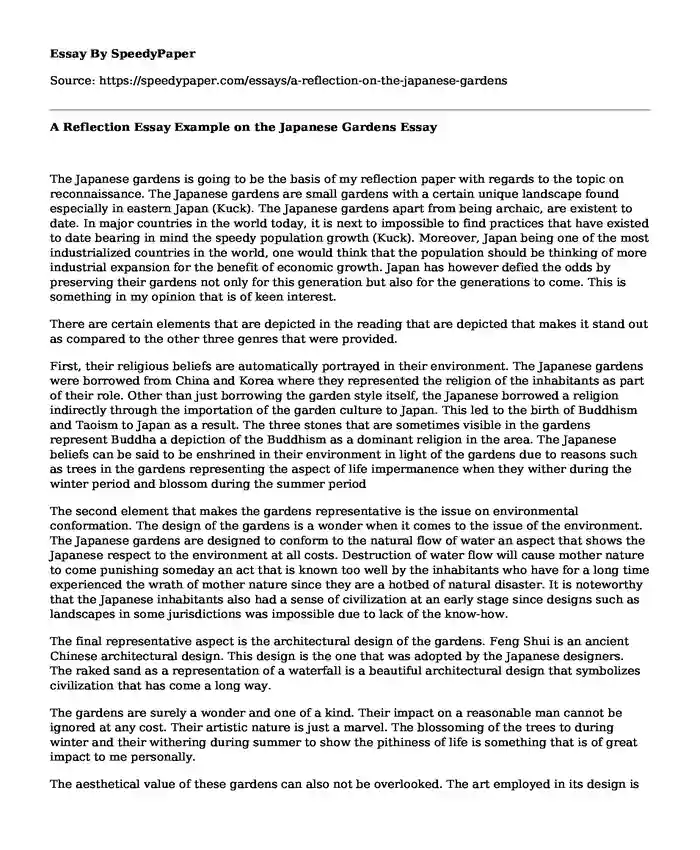The Japanese gardens is going to be the basis of my reflection paper with regards to the topic on reconnaissance. The Japanese gardens are small gardens with a certain unique landscape found especially in eastern Japan (Kuck). The Japanese gardens apart from being archaic, are existent to date. In major countries in the world today, it is next to impossible to find practices that have existed to date bearing in mind the speedy population growth (Kuck). Moreover, Japan being one of the most industrialized countries in the world, one would think that the population should be thinking of more industrial expansion for the benefit of economic growth. Japan has however defied the odds by preserving their gardens not only for this generation but also for the generations to come. This is something in my opinion that is of keen interest.
There are certain elements that are depicted in the reading that are depicted that makes it stand out as compared to the other three genres that were provided.
First, their religious beliefs are automatically portrayed in their environment. The Japanese gardens were borrowed from China and Korea where they represented the religion of the inhabitants as part of their role. Other than just borrowing the garden style itself, the Japanese borrowed a religion indirectly through the importation of the garden culture to Japan. This led to the birth of Buddhism and Taoism to Japan as a result. The three stones that are sometimes visible in the gardens represent Buddha a depiction of the Buddhism as a dominant religion in the area. The Japanese beliefs can be said to be enshrined in their environment in light of the gardens due to reasons such as trees in the gardens representing the aspect of life impermanence when they wither during the winter period and blossom during the summer period
The second element that makes the gardens representative is the issue on environmental conformation. The design of the gardens is a wonder when it comes to the issue of the environment. The Japanese gardens are designed to conform to the natural flow of water an aspect that shows the Japanese respect to the environment at all costs. Destruction of water flow will cause mother nature to come punishing someday an act that is known too well by the inhabitants who have for a long time experienced the wrath of mother nature since they are a hotbed of natural disaster. It is noteworthy that the Japanese inhabitants also had a sense of civilization at an early stage since designs such as landscapes in some jurisdictions was impossible due to lack of the know-how.
The final representative aspect is the architectural design of the gardens. Feng Shui is an ancient Chinese architectural design. This design is the one that was adopted by the Japanese designers. The raked sand as a representation of a waterfall is a beautiful architectural design that symbolizes civilization that has come a long way.
The gardens are surely a wonder and one of a kind. Their impact on a reasonable man cannot be ignored at any cost. Their artistic nature is just a marvel. The blossoming of the trees to during winter and their withering during summer to show the pithiness of life is something that is of great impact to me personally.
The aesthetical value of these gardens can also not be overlooked. The art employed in its design is something that leaves a lot to be asked. The symbolism employed in its design such as the three stones to represent Buddha and the raked sand to represent water flow is something that brings out the aesthetic value of the gardens (Slawson). Beauty in its general meaning is not just something or someone that looks good on the face of it. Beauty should be able to speak for itself in a way that can be understood not by anyone but only by those whom it is designed to communicate to leaving the rest of the world guessing. The Japanese gardens have not failed under this definition. They speak a lot about the Japanese culture but only the Japanese understand it (Slawson). The rest of the world only marvel at its uniqueness while at the same time understanding close to nothing on the very meaning of the Japanese gardens. That to me is beauty.
Works Cited
Kuck, Loraine E. The art of Japanese gardens. The John Day Company, 1940.
Slawson, David A. Secret teachings in the art of Japanese gardens. Kodansha International, 1991.
Cite this page
A Reflection Essay Example on the Japanese Gardens. (2019, Jun 03). Retrieved from https://speedypaper.com/essays/a-reflection-on-the-japanese-gardens
Request Removal
If you are the original author of this essay and no longer wish to have it published on the SpeedyPaper website, please click below to request its removal:
- Essay Example about Germany's Healthcare
- Free Essay Sample on Indigenous Education in Australia
- Not Like Us: Immigrants and Minorities in America - Book Review in a Free Essay
- Art Essay Example: Formal Analysis of Marilyn (Vanitas)
- Essay Example: Impact of Special Trade Zones in India on a Socio-Economic Level
- Essay Sample on College Student Suicide
- Essay Sample on the Security Environment
Popular categories





